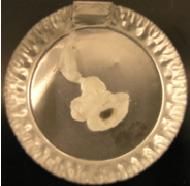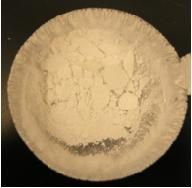Ion Imprinted Polymer for Removal and Monitoring of Arsenic (Phase II)

Harjyoti is a second year graduate (Ph.D) student in Materials and Nanotechnology Program at North Dakota State University (NDSU). He started for his graduate program from Fall 2007. He did his MS program in Chemistry (2006) from the prestigious Indian Institute of Technology (IIT) Guwahati and his BS program from Gauhati University, India (2004).
His doctoral research focuses on the synthesis of ion-imprinted polymers and use them to remove arsenic from water and to detect aqueous arsenic.
Email:Harjyoti.Kalita@ndsu.edu
Phone: 701-200-5109
Fellow: Harjyoti Kalita
Advisor: Achintya Bezbaruah, Ph.D., Assistant Professor, Department of Civil Engineering, North Dakota State University.
Co-Advisor: Bret Chisholm, Ph.D., Senior Research Scientist, Center for Nanoscale Science and Engineering and Adjunct Professor, Polymers and Coatings, North Dakota State University.
Matching Support: North Dakota State University.
Degree Progress: Ph.D. in Environmental Engineering expected in Spring 2011
Ion Imprinted Polymer for Removal and Monitoring of Arsenic (Phase II)
Introduction of the Project:
Arsenic pollution in drinking water is a serious environmental and health concern because of its high toxicity. The harmful effects in human are because of formation of different methylated arsenic compounds which are very toxic. The U.S. EPA lowered the maximum containment level (MCL) for arsenic to 10 ppb from earlier 50 ppb in drinking water in 2006. Available technology to remove arsenic include conventional processes for oxidation of As(III) to As(V), coprecipitation and adsorption, adsorption, ion exchange method, and membrane filtration. Most of the available methods fail to remove As(III) unless it is oxidized to As(V). There is still need to develop an effective methods to remove both As(III) and As(V) species from water which can be used for household purposes and in small water treatment plants. The most important criterion for the selection of a new method is that it should be able to remove arsenic to below 10 ppb at relatively low cost. Again, there are available instrumentation techniques to detect aqueous arsenic. These techniques are well established but they need bulky instruments, high cost for analysis, and significant operator expertise. So a simple, reliable and cost effective detection technique (with detection limit < 10 ppb) is necessary to detect arsenic in households and small utilities.
Solid phase extraction is one of the most promising technologies for the removal of various metal ions (contaminants) from aqueous medium. Advantages of solid phase extraction are: (a) high enrichment factor, (b) low cost of synthesis, (c) use of less hazardous materials, and (d) flexibility of the method. Even though there are different solid phase extraction methods, ion imprinted polymers (IIP) are potential candidates with high probability of success. They are low cost, compatible with different environments, and have high selectivity relative to the conventional solid sorbents. The present project is targeted towards development of an IIP for the removal of As(III) and As(V).
The work proposed here is the continuation of 2008 NDWRRI program.
Project Objectives:
- Preparation an ion imprinted polymer (IIP) for selective removal of arsenic from water.
- Optimization of sorption and selectivity studies of IIP for arsenic ion.
- Preparation of electrode to detect arsenic ion.
Progress:
The progress made during the last year is summarized below:
Task I: Ternary complex formation: Thiol- arsenic complex was synthesized.
Task II: Synthesis of polymer: The complex formed in task I was imprinted in styrene-divinyl benzene copolymer (Figure 1).
Task III: Preparation of IIP: The polymer material was filtered and then dried in vacuum to get the IIP (Figure 2).
The effects of various parameters (e.g., pH, temperature, different cross-linker, reaction time) ware analyzed to find out the optimal conditions. ICP-OES analysis was carried out to see the binding of arsenic with the polymer.
Research Outputs from 2008 Fellowship Program:
Kalita, H., Chisholm, B., J., Bezbaruah, A., N. “Ion-imprinted Polymers: A new Approach to Remove Arsenic from Drinking Water”. AWWA, Surface Water Conference, April 2008 (Poster Presentation).
Kalita, H., Chisholm, B. J., Bezbaruah, A. N. Effects of different graft copolymer constituent groups on sedimentation characteristics of coated iron nanoparticles, PMSE Preprints, 2009, 100, 683-685.
Krajangpan, S., Chisholm, B.J., Kalita, H., and Bezbaruah, A.N. Challenges in Groundwater Remediation with Iron Nanoparticles: Enhancement Colloidal Stability (Chapter 8) in Nanotechnologies for Water Environment Applications (Eds: Tian C. Zhang, , Rao Y. Surampalli, Keith C. K. Lai, Zhiqiang Hu, R. D. Tyagi, and Irene M. C. Lo), American Society for Civil Engineers/EWRI, pp. 191-212, 2009. ISBN: 978-0-7844-1030-1
Significance:
The new ion imprinted polymer (IIP) can be used to remove both As(III) and As(V) simultaneously at a very low cost. The outcomes from this work will have universal appeal and will be very relevant to North Dakota. Arsenic contamination is a major concern in southeast North Dakota (568 sq mile area in Sargent, Ransom and Richland counties are affected). Again published data (February 2000) show that 30 water treatment plants in ND are not able to remove arsenic up to 10 ppb MCL. IIP based processes will be very useful in rural areas, small community treatment plants, and in individual households. Ion-imprinted chemical sensor technology will have potential applications not only in environmental engineering but also in clinical diagnostics, environmental and food analyses as well as in illicit drugs detection, genotoxicity and chemical weapons.



Achintya Bezbaruah
Civil & Environmental Eng.
Office: Civil/Ind Eng 201G
Telephone: 701-231-7461
Email: a.bezbaruah@ndsu.edu

Bret Chisholm
Center for Nanoscale Science and Engineering
NDSU


